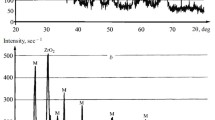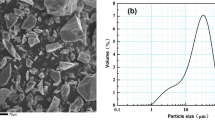Abstract
The processes of mullitization of high-temperature ceramic mixtures containing metadiabase are investigated. The quantitative relationship between mullite, quartz, and plagioclase is demonstrated. It is established that the introduction of 30 wt.% metadiabase at firing temperatures of 1180–1200°C accelerates the mullitization process and facilitates the formation of mullite with a more perfect structure. Mullite in ceramic mixtures is mostly crystallized from the kaolinite residue, as well as from plagioclase grains.
Similar content being viewed by others
References
V. F. Pavlov, “The effect of chemical and phase composition on acid resistance of ceramic articles,”Publ. NIStroikeramika Inst., Issues 40–41, 240–258 (1974).
V. O. Lapin, N. Ya. Gosin, and I. I. Ovsyannikova, “Kaolinite-hydromica and kaolinite clays and the role of various iron ore additives in their use,” in:The Study and Application of Clays and Argillaceous Materials [in Russian], Nauka, Alma-Ata (1970), pp. 211–217.
I. A. Levitskii, V. A. Biryuk, A. P. Chernyak, and Yu. G. Pavlyukevich, “The study of kaolins in Belarus for the purpose of assessing the possibilities of their application in production of ceramic articles,”Vestsi Nat. Akad. Nauk. Beharusi, Ser. Khim. Nauki, No. 2, 98–102 (1998).
Yu. G. Pavlyukevich, I. A. Levitskii, N. V. Aksamentova, Yu. S. Radchenko, “Comprehensive study of base rocks as raw material for ceramic production,”Steklo Keram, No. 11, 6–11 (1998).
V. F. Pavlov,Physicochemical Principles of Firing Construction Ceramics [in Russian], Stroiizdat, Moscow (1977).
G. I. Kovalev, A. A. Lukovkina, V. V. Korotkina, and A. P. Pyzhova, “On the specifics of the mineral composition of the Veselovskoe clays,”Steklo Keram, No. 1, 19–21 (1980).
O. S. Grum-Grzhimailo, “Formation of primary mullite in porcelain,”Steklo Keram. No. 6, 26–27 (1973).
O. S. Grum-Grzhimailo, “X-ray structural analysis of new mullite formations in acid-resistant materials,”Publ. NIIStroikeramika Inst., 128–131 (1981).
A. Neuhaus and W. Richart, “Uber die Einkristallzuchtung und Zustandsverhaltnisse vor Mullit,”Ber. Dtsch. Keram. Ges.,35(4), 108–116 (1958).
O. S. Grum-Grzhimailo and O. S. Gorshkova, “On the problem of sanitary porcelain formation,”Publ. NIIStroikeramika Inst., Issue 52, 22–30 (1983).
Author information
Authors and Affiliations
Additional information
Translated from Steklo i Keramika, No. 8, pp. 19–22, August, 1999.
Rights and permissions
About this article
Cite this article
Palyukevich, Y.P., Levitskii, I.A. Phase formation in ceramic mixtures containing metadiabase. Glass Ceram 56, 252–255 (1999). https://doi.org/10.1007/BF02681506
Issue Date:
DOI: https://doi.org/10.1007/BF02681506




